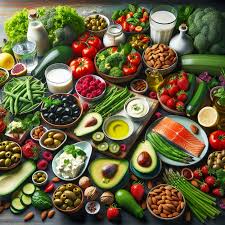Discover the Top 10 Healthiest Foods and Their Secrets

Nutrition plays a pivotal role in our overall health and well-being, acting as the cornerstone upon which our bodies thrive and so the question: What are top 10 Healthiest Foods? They are Leafy Greens, Berries, Nuts and Seeds, Fatty Fish, Whole Grains, Cruciferous Vegetables, Legumes, Greek Yogurt, Avocado, and Tomatoes.
The foods we consume serve as fuel for our bodies, providing essential nutrients that support bodily functions, regulate metabolism, and ward off disease.
Amidst the vast array of food choices, certain foods stand out for their exceptional nutritional profiles and health benefits.
In this article, we embark on a journey to uncover the secrets of the top 10 healthiest foods, exploring their unique properties and the science behind their remarkable health-promoting effects.
Superfood Spotlight
Defining Super Foods: What Makes a Food Healthy?
The term “superfood” has gained popularity in recent years, but what exactly qualifies a food as super? Superfoods are nutrient-dense foods that are rich in vitamins, minerals, antioxidants, and other beneficial compounds that are known to promote health and well-being.
The Quest for Nutrient Density
When evaluating foods for their superfood status, nutrient density is key. Healthiest foods provide a high concentration of essential nutrients relative to their caloric content, making them valuable additions to a balanced diet.
Unveiling the Top 10 Healthiest Foods
Factors Considered in Choosing the Top 10
Selecting the top 10 healthiest foods involves careful consideration of various factors, including nutrient density, scientific research, and health benefits.
Each food chosen for this list has been meticulously evaluated based on the Healthiest Foods criteria.
Without further ado, let’s unveil the top 10 healthiest foods that have earned their place on this esteemed list.
From leafy greens to fatty fish, each of these superfoods boasts an impressive nutritional profile and a host of health-promoting properties.
Leafy Greens: The Powerhouses of Nutrition
Nutritional Profile: Vitamins, Minerals, and Antioxidants
Leafy greens such as kale, spinach, and Swiss chard are nutritional powerhouses, packed with vitamins A, C, and K, as well as minerals like iron, calcium, and magnesium.
Additionally, they are rich in antioxidants, which help protect cells from damage caused by free radicals.
Health Benefits
The consumption of leafy greens has been linked to a myriad of health benefits, including strengthened immune function, improved heart health, and reduced risk of chronic diseases such as cancer and diabetes.
Incorporating leafy greens into your diet can help promote overall health and well-being.
Berries: Nature’s Antioxidant-Rich Gems
Berry Bonanza: Exploring the Variety of Berries
From strawberries and blueberries to raspberries and blackberries, the berry family offers a diverse array of flavors and colors.
Despite their small size, berries are packed with antioxidants, vitamins, and fiber, making them nutritional powerhouses.
Antioxidant Power
One of the key secrets behind the health benefits of berries lies in their high antioxidant content.
Antioxidants help neutralize free radicals in the body, thereby reducing oxidative stress and inflammation and protecting against aging and disease.
Nuts and Seeds: Tiny Packages of Nutritional Goodness
Nutrient Profile
Nuts and seeds are nutrient-dense foods that provide a wealth of healthiest Foods including healthy fats, protein, fiber, vitamins, and minerals.
Examples include almonds, walnuts, chia seeds, and flaxseeds, each offering a unique nutritional profile.
Heart Health Heroes: Lowering Cholesterol and Supporting Brain Function
The consumption of nuts and seeds has been associated with numerous health benefits, particularly concerning heart health and brain function.
Their rich content of unsaturated fats, omega-3 fatty acids, and plant sterols helps lower cholesterol levels, reduce inflammation, and support cognitive function.
Fatty Fish: Omega-3-Rich Champions
Omega-3 Fatty Acids: Essential for Brain and Heart Health
Fatty fish such as salmon, mackerel, and sardines are renowned for their high omega-3 fatty acid content, particularly EPA and DHA.
These essential fatty acids play crucial roles in brain development, cognitive function, and cardiovascular health.
Fishy Facts
When selecting fatty fish, it’s important to choose wild-caught, sustainably sourced varieties whenever possible to minimize exposure to environmental contaminants such as mercury and PCBs.
Additionally, incorporating a variety of fish into your diet ensures a diverse array of nutrients and reduces the risk of overexposure to contaminants.
Whole Grains: Fiber-Filled and Nutrient-Rich
Fiber Focus: Supporting Digestive Health and Weight Management
Whole grains such as quinoa, brown rice, oats, and barley are rich in dietary fiber, which plays a crucial role in supporting digestive health, regulating blood sugar levels, and promoting satiety and weight management.
Beyond Wheat: Exploring the Diversity of Whole Grains
While wheat is perhaps the most well-known grain, there is a wide variety of whole grains to explore, each offering its own unique nutritional benefits.
Experimenting with ancient grains like amaranth, farro, and teff can add diversity and flavor to your diet while boosting your intake of essential nutrients.
Cruciferous Vegetables: Cancer-Fighting Superstars
Sulforaphane Superpowers: Detoxification and Disease Prevention
Cruciferous vegetables such as broccoli, Brussels sprouts, cauliflower, and kale contain a compound called sulforaphane, which has been shown to have potent anti-cancer properties.
Sulforaphane helps activate enzymes in the body that promote detoxification and protect against carcinogens.
Incorporating Cruciferous Veggies into Your Diet
Adding more cruciferous vegetables to your diet is easy and delicious. Try roasting Brussels sprouts with olive oil and garlic, adding broccoli to stir-fries, or incorporating kale into smoothies and salads for a nutritional boost.
Legumes: Plant-Based Protein Powerhouses
Protein Packed: Building Muscle and Sustaining Energy
Legumes such as beans, lentils, and chickpeas are excellent sources of plant-based protein, making them valuable additions to vegetarian and vegan diets.
Protein is essential for muscle repair and growth, as well as for providing sustained energy throughout the day.
Gut Health Guardians: Boosting Digestive Regularity and Gut Flora
In addition to their protein content, legumes are rich in fiber, which supports digestive health by promoting regularity and feeding beneficial gut bacteria.
Incorporating legumes into your meals can help maintain a healthy gut microbiome and reduce the risk of digestive issues such as constipation and bloating.
Greek Yogurt: Probiotic-rich and Protein-Packed
Probiotic Benefits: Supporting Digestive Health and Immunity
Greek yogurt is a fermented dairy product that contains probiotics, beneficial bacteria that promote digestive health and support immune function.
Probiotics help maintain a healthy balance of gut bacteria, which is essential for proper digestion and immune system function.
Protein Punch: Fueling Muscles and Satisfying Hunger
In addition to its probiotic content, Greek yogurt is also an excellent source of protein, making it a satisfying and nutritious snack or meal option.
Protein helps repair and build muscle tissue, regulate appetite, and keep you feeling full and satisfied for longer periods.
Avocado: Creamy, Delicious, and Nutrient-Dense
Healthy Fats: Supporting Heart Health and Brain Function
Avocado is renowned for its creamy texture and rich flavor, but it also boasts an impressive nutritional profile.
Avocados are loaded with heart-healthy monounsaturated fats, which help lower cholesterol levels and reduce the risk of heart disease.
Additionally, these fats are essential for brain function and cognitive health.
Versatile Avocado: From Toast Toppers to Guacamole Goodness
One of the best things about avocados is their versatility. From spreading avocado on toast to adding it to salads, sandwiches, and smoothies, there are countless ways to incorporate this nutritious fruit into your diet.
Avocado also serves as the primary ingredient in guacamole, a delicious dip that pairs well with chips, tacos, and other Mexican dishes.
Tomatoes: Vibrant and Versatile Nutritional Powerhouses
Lycopene Benefits: Protecting Against Cancer and Heart Disease
Tomatoes are not only delicious but also incredibly nutritious. They are rich in lycopene, a powerful antioxidant that has been linked to a reduced risk of cancer, heart disease, and other chronic conditions.
Lycopene helps neutralize free radicals in the body, thereby reducing oxidative stress and inflammation.

Cooking Tips: Maximizing Nutrient Absorption and Flavor
To maximize the nutritional benefits of tomatoes, consider cooking them with a healthy fat such as olive oil, which helps enhance the absorption of lycopene.
Additionally, adding fresh herbs and spices to tomato-based dishes can elevate their flavor profile while providing additional health benefits.
Cracking the Code: The Secrets Behind Their Health Benefits
Unveiling the Nutritional Secrets of Each Superfood
Each of the top 10 healthiest foods has its unique nutritional secrets that contribute to its remarkable health-promoting effects.
From antioxidant-rich berries to omega-3-packed fatty fish, understanding the science behind these superfoods can help you make more informed choices about your diet.
How They Support Overall Health and Well-being
In addition to their nutritional benefits, the top 10 healthiest foods also work synergistically to support overall health and well-being.
By incorporating a diverse array of nutrient-dense foods into your diet, you can optimize your nutrition and reap the rewards of better health.
Incorporating Superfoods Into Your Diet
Practical Tips for Adding Superfoods to Your Meals
Incorporating superfoods into your diet doesn’t have to be complicated. Simple changes like adding berries to your morning oatmeal, tossing leafy greens into your salads, or snacking on nuts and seeds can make a big difference in your overall health.
Recipes and Meal Ideas to Inspire Your Culinary Creations
Looking for inspiration? Check out our collection of superfood recipes and meal ideas to help you get started.
From smoothie bowls and grain salads to seafood dishes and veggie-packed stir-fries, there are endless possibilities for incorporating superfoods into your culinary creations.
Navigating Superfood Supplements: Are They Worth It?
Pros and Cons of Superfood Supplements
While whole foods should always be your primary source of nutrition, superfood supplements can be a convenient way to boost your intake of essential nutrients.
However, it’s essential to weigh the pros and cons of supplements and choose wisely based on your individual needs and preferences.
Making Informed Decisions about Supplementing Your Diet
Before adding superfood supplements to your regimen, consult with a healthcare professional to ensure they are safe and appropriate for you.
Keep in mind that supplements are not a substitute for a healthy diet and lifestyle but can complement your efforts to optimize your nutrition.
Conclusion
In conclusion, the top 10 healthiest foods offer a wealth of nutritional benefits that can support overall health and well-being.
From leafy greens and berries to fatty fish and whole grains, these nutrient-rich superfoods are essential components of a balanced diet.
By incorporating the top 10 healthiest foods into your diet and understanding the secrets behind their health benefits, you can empower yourself to make healthier choices and optimize your nutrition.
Remember, small changes can lead to significant improvements in your health over time. Here’s to a happier, healthier you!









